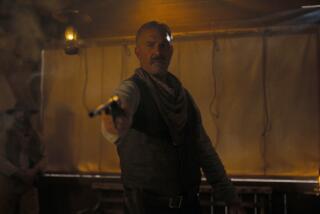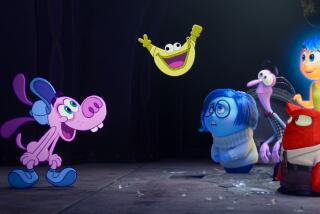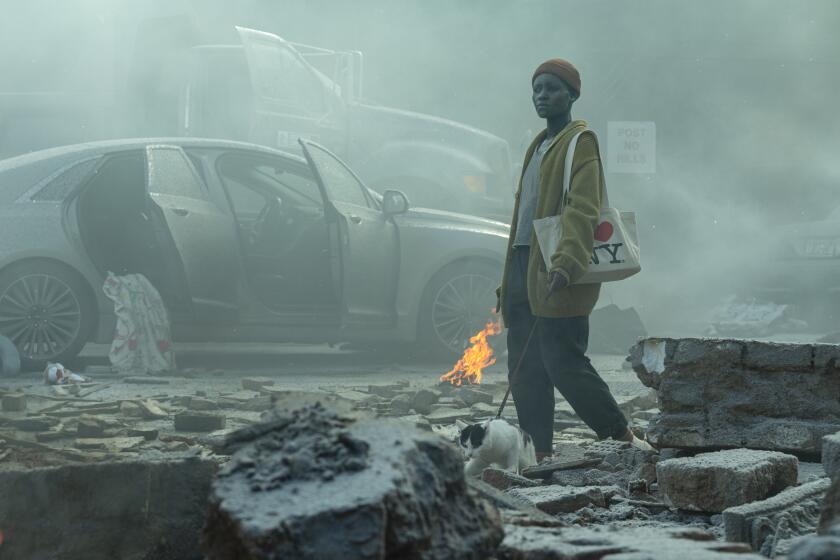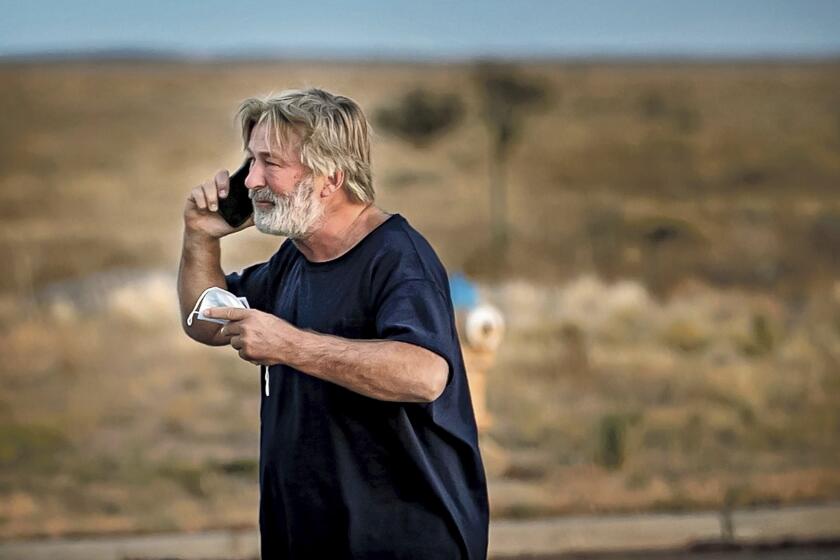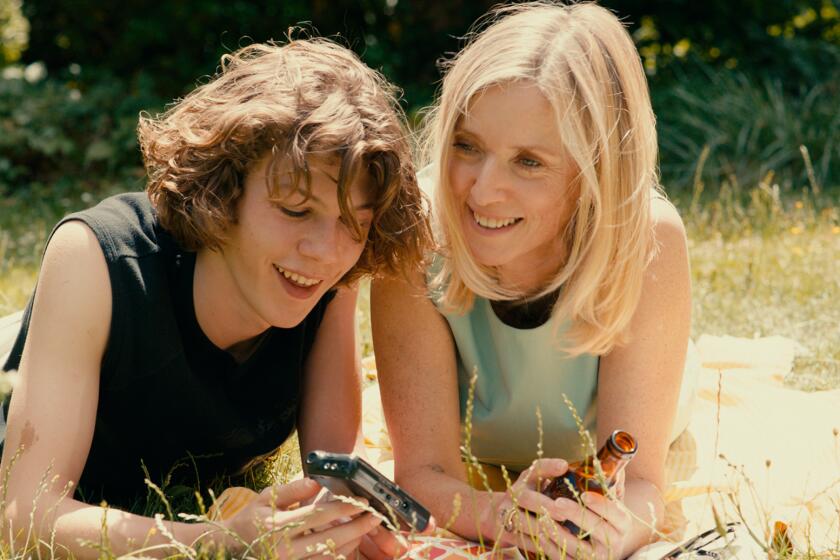When evil is on the prowl
Director E. Elias Merhige, whose new psychological thriller “Suspect Zero” opens Friday, isn’t your everyday Hollywood filmmaker.
A former visual artist and poet, he thinks of film as “a collective dream” and of himself as a tribal storyteller targeting “the universal.”
Frustrated with linear exposition and the limitations of language, the onetime New Yorker is less concerned with dialogue than with allegory, imagery and “the poetic spaces” between characters. “Begotten,” his 1991 black-and-white feature debut, had no words.
Still, embraced by such literati as Susan Sontag, the archetypal creation myth landed on Time magazine’s top 10 list that year.
So impressed was Nicolas Cage with the footage that he hired Merhige to direct 2000’s “Shadow of the Vampire,” a $6-million German Expressionist-style commentary on the creative process in the guise of a vampire movie. Oscar-nominated for cinematography and makeup, it landed Independent Spirit and Los Angeles Film Critics Assn. awards for Willem Dafoe as best supporting actor.
It also paved the way for “Suspect Zero,” the director’s first mainstream Hollywood effort, which Paramount Pictures will release in 1,500 theaters.
In it, Merhige again delves into the dark side: the disturbing, psychic bond between onetime CIA agent Benjamin O’Ryan (Ben Kingsley) and current FBI operative Thomas Mackelway (Aaron Eckhart), who’s chasing a serial killer with the help of his former partner (Carrie-Anne Moss). Using “remote viewing” technology, O’Ryan transmits telepathic clues about the whereabouts of the culprit, raising questions about whether he’s on the trail of the man or is actually the monster himself.
Merhige’s fixation with the underbelly is rooted in childhood fears and dreams, the director explained, especially a near-fatal car accident at 19. No longer breathing, he became aware of a “ghostly hyper-reality,” layers that exist simultaneously.
“Suspect Zero,” budgeted in the $20-million-plus range, is not only a cat-and-mouse tale but also a portrait of an ordinary world turned upside down, he observed. The killer is everywhere and nowhere, a force of nature rather than a fleshed-out character. O’Ryan has turned into a giant beast with images he can’t shut off.
“In our post 9/11 world, we’ve obliterated good and evil, creating a fat, gray abyss,” said Merhige, 40. “There are things on the periphery you can’t put into words. Opening a letter can give you anthrax. Passenger planes are used as missiles. We watch beheadings on TV. The biggest industry in this country is antidepressants because we’re always waiting for the other shoe to drop.”
A fan of silent-film master Sergei Eisenstein and Spanish surrealist Luis Bunuel, Merhige was told by the late Aram Avakian, his professor at the State University of New York at Purchase, that “Begotten,” his senior thesis, would be in film history books within a decade. Described by one reviewer as a “metaphysical splatter film,” it had a love-hate relationship with its audience. Still, the $33,000 film acquired a cult following and was shown at New York City’s Museum of Modern Art and Washington, D.C.’s Smithsonian Institution, opening doors for the maverick director.
Uninterested in the offers, Merhige abandoned feature films for a decade to direct stage productions, teach acting in Belgium and create a music video for gothic artist Marilyn Manson. MTV considered that 1996 Manson video, “Anti-Christ Superstar,” so intense that it pulled it off the network.
“Shadow of the Vampire,” portraying the shoot of the 1922 horror classic “Nosferatu,” was Merhige’s professional breakthrough.
One month after the Oscar ceremony, he received the script for “Suspect Zero,” which he spent six months rewriting because he considered it too “straightforward” and “procedural.”
In a twist on horror film conventions, Merhige set the movie at high noon with a cloudless sky and limitless landscape rather than playing off deep shadows. Shooting in blazing sunlight rather than nighttime creates oppressiveness, he said.
Being a filmmaker is a huge responsibility, Merhige said, particularly in a business focused on “making the turnstiles click.”
Straddling the line between art and entertainment, he said, he’s exploring the darker side of human experience to liberate the light.
“I have a strong antenna, picking up things that I turn into stories and images,” said Merhige, who’s working on a screenplay about the many levels of love.
“It’s a homeopathic way of bringing truth and beauty to people. Not everyone can make that leap, of course.
“One person’s work of art is another’s aberration.”
*
(BEGIN TEXT OF INFOBOX)
‘Remote viewing’
“Suspect Zero” director E. Elias Merhige read about “remote viewing” technology when it was declassified in the 1990s, and later incorporated it into the script.
What is it? In the early 1970s, the military, Central Intelligence Agency and National Security Agency brought together a group of physicists and psychics to tap into the human capacity for extrasensory perception. The aim: developing mind-to-mind connection (telepathy) and the ability to experience a distant target (clairvoyance).
How was it used? Information from remote viewing is credited with helping reveal Chinese atomic bomb tests as well as Soviet missile sites and weapons factories.
How effective was it? Millions were spent in development and testing, but it has largely been abandoned because of poor results.
Director’s comments: “Researching the film, I went to Austin, Texas, to take a crash course in the methodology. A group of experts drove to a distant location and I started putting images on paper. Knowing nothing about where they were, I felt the wind, I saw the river -- even the angle of the girders. In the end, I was 75% accurate, not bad for a beginner. Nature, I’ve discovered, speaks to us on a multitude of levels.”
More to Read
Only good movies
Get the Indie Focus newsletter, Mark Olsen's weekly guide to the world of cinema.
You may occasionally receive promotional content from the Los Angeles Times.
